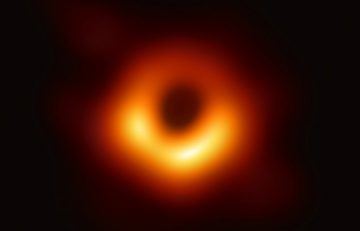Surekha Davies in Aeon:
 There it floated, a luminous orange doughnut, glowing and fuzzy-edged, against a sea of darkness (Figure 1, below). Had it arrived without headline or caption, the world’s first ever image of a black hole might not have been recognised. Relayed across global news media, in April 2019, with appropriate fanfare and explanation, it caused the kind of stir you might expect of a scientific breakthrough. Prior to this, black holes had been ‘seen’ with the eye only through the images of science fiction. But now that we had a visual fix on black holes, an entity known only through abstract theory and via its gravitational effects on other bodies, were we any the wiser about them?
There it floated, a luminous orange doughnut, glowing and fuzzy-edged, against a sea of darkness (Figure 1, below). Had it arrived without headline or caption, the world’s first ever image of a black hole might not have been recognised. Relayed across global news media, in April 2019, with appropriate fanfare and explanation, it caused the kind of stir you might expect of a scientific breakthrough. Prior to this, black holes had been ‘seen’ with the eye only through the images of science fiction. But now that we had a visual fix on black holes, an entity known only through abstract theory and via its gravitational effects on other bodies, were we any the wiser about them?
The image of M87* (the supermassive black hole at the centre of galaxy Messier 87) is the remarkable result of the efforts of researchers working with the international Event Horizon Telescope. At first sight so novel and game-changing, this unprecedented image is not the ‘photograph’ it appears to be. Instead it’s part of a long tradition of diagrammatically representing the heavens that stretches back at least as far as Galileo’s time-lapse sketches of sun spots, observed through a telescope at the turn of the 17th century. Galileo also made drawings of the Moon’s ridges and valleys, extrapolating imaginatively – from shifting light and dark patterns across the Moon’s phases – to surmise its physical features.
Perhaps more surprisingly, the black hole image has a lot in common with much earlier images of another sort of deep space, containing a different hidden entity: the sea monster.
More here.
